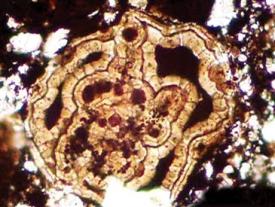 |
 |
 |
 |
 |
Produced
by the Population Genetics and Evolution class, Furman University |
||||
 |
 |
 |
 |
 |
Produced
by the Population Genetics and Evolution class, Furman University |
||||
 |
The
Ediacaran: Vernanimalcula |
 |
| Vernanimalcula
guizhouena was a tiny ocean-dwelling organism
that is the oldest known bilaterian, or bilaterally symmetrical animal
(Sutliff 2004). Nearly microscopic, they may have fed on bacteria and
other microbes (Sutliff 2004). Its discovery in the Guizhou Province in
southern China in 2004 suggested the existence of bilaterians as early
as 600 million years ago (Mullen 2004). These organisms are believed to
be bottom dwellers, possessing distinct parts of the body including the
mouth, anus, and pits believed to have sensory capabilities (Sutliff 2004).
This finding was significant in that bilaterally symmetrical organisms
were previously believed to have been associated with the Cambrian Explosion
that began around 550 million years ago (Mullen 2004). This period was
noted for a sudden rapid expansion of diversity in living forms. Kimberella,
a mollusk-like organism that lived about 20 to 30 million years prior
to the Cambrian Explosion, was previously the oldest known bilaterian
until the finding of the Vernanimalcula guizhouena implicated
the existence of bilaterians much earlier than previously thought (Mullen
2004). A degree of controversy remains, however, as there is doubt surrounding
the conclusiveness of the fossil’s discovery. Some insist that the
analysis didn’t factor in the possibility of the organism changing
after death, known as taphonomy, or changes occurring in the surrounding
sediment after deposition, known as diagenesis (Bengtson and Budd 2004).
Despite such claims, most scientists still view Vernanimalcula guizhouena
as the earliest known bilaterian. Page by LinLin Zhao |
 |
| Vernanimalcula guizhouena. Photo Credit: Astrobiology Magazine. | |
| Sutliff,
U. 2004. Changing the timeline. USCNews. University of Southern CalifornialAccessed
24 January 2010. Mullen, L. 2004. Earliest bilateral fossil found. Astrobiology Magazine. Accessed 25 January 2010. Bengtson, S. and G. Budd. 2004. Comment on “Small Bilaterian Fossils from 40 to 55 Million Years Before the Cambrian”. Science. 306: 1291. |